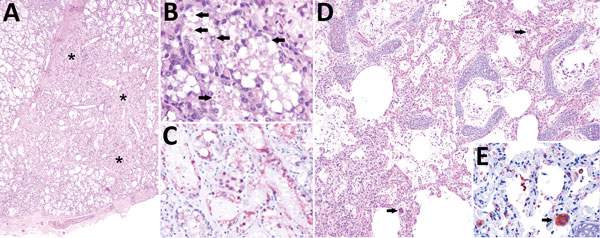Volume 24, Number 7—July 2018
Dispatch
Guiana Dolphin Unusual Mortality Event and Link to Cetacean Morbillivirus, Brazil
Figure 2

Figure 2. Cetacean morbillivirus–associated histopathologic findings in 2 Guiana dolphins (Sotalia guianensis), a female adult (case 1, panels A–C) and a male calf (case 2, panels D–E). A) The mammary gland parenchyma is focally disrupted by lymphohistiocytic inflammatory cells (not visible at this magnification) associated with collapsed and lost acini, and mild fibrosis (asterisks). Original magnification ×40; hematoxylin and eosin (H&E) stain. B) Swollen and degenerating mammary acinar epithelial cells have numerous intracytoplasmic and intranuclear inclusion bodies (arrows). Original magnification ×200; H&E stain. C) Degenerating and sloughed mammary acinar epithelial cells have intense granular cytoplasmic and intranuclear immunolabeling, identified by immunohistochemistry (IHC) for canine distemper virus (CDV), known to cross react with cetacean morbilliviruses. D) Pulmonary area displaying interstitial pneumonia with mildly thickened alveolar septa and alveoli containing proteinaceous edema, scattered fibrin strands, and small numbers of pleocellular inflammatory cells including occasional syncytia (arrows). Original magnification ×100; H&E stain. E) Degenerating and necrotic type I pneumocytes, sloughed and adhered type II pneumocytes, alveolar and septal macrophages, syncytia (arrow) and circulating (intravascular) mononuclear cells display intense immunolabeling. Original magnification ×400; IHC for CDV.